❗️🇷🇺🇺🇦 Soledar direction
situation as of 13.00 January 13, 2023
🔻In the Soledar sector, the assault detachments of the PMC "Wagner" are cleaning the quarters and underground communications on the western outskirts of Soledar. Today, the "Wagnerites" entered the territory of the urban-type settlement of Sol and established control over the depot of the railway station of the same name.
▪️In the north-west of Soledar, active battles are taking place on the southern outskirts of Krasnaya Gora and in Paraskovievka near the Bakhmutka River. After the liberation of the railway station Sol, the village of Blagodatnoye was actually cut off from the supply lines from Seversk and Bakhmut.
▪️The surviving members of the Armed Forces of Ukraine in Soledar and its environs are spreading information about huge losses in manpower due to command errors. In one of the brigades in the company of the formation, only 30 people remained, and in the battalion of 24th Mechanized brigade (OMBr) ,out of 300, only 100 fighters survived.
🔻Fighting continues in Bakhmut and its suburbs. After the liberation of the village, Opytne (Opytnoye), by PMC "Wagner" ,position of the Armed Forces of Ukraine in Bakhmut is deteriorating.
▪️In Minkovka, a reserve command post for the consolidated group has been equipped, and the forces of the 116th brigade of the territorial defense of the Armed Forces of Ukraine from the Sumy region are expected to arrive in this direction.
▪️As a result of the active offensive of the RF Armed Forces, the Armed Forces of Ukraine lost control over two company and two platoon strongholds in Bakhmut, Kleshcheevka and Krasnaya Gora.
▪️Only on January 12, confirmed losses of Ukrainian formations in Bakhmut amounted to 100 people, and 39 were wounded. To strengthen positions, 600 mobilized without combat experience are expected to be transferred in the near future.
▪️According to the radio interception from Bakhmut, over 800 people have been killed over the past five days, not counting the missing and wounded.
In addition, individual units of Polish mercenaries, who were transferred to the direction a few weeks earlier, suffered huge losses.
The Poles spread information about the loss of communication and the complete disunity between the formations in Bakhmut and the surrounding area. The moral and psychological state of mercenaries is at a low level.
▪️The forces of the 3rd Battalion of the 28th mechanized brigade (OMBr) of the Armed Forces of Ukraine attempted a counteroffensive on Russian positions southwest of Bakhmut. The attack was repulsed, and separate detachments of the 28th Brigade fled from the combat area.
🔻The leadership of the Ukrainian operational-tactical group "Soledar" assesses the situation as critical and expects the intensification of the offensive of Russian troops at the Berestovoye-Spornoye line in order to reach the Seversk agglomeration, as well as in the south at the Ozaryanovka-Mayorsk line towards Druzhba and Dyleevka.
The liberation of Opytnoye allows the Russians to start advancing on the southern outskirts of Bakhmut, as well as attacking the fortified areas of the Armed Forces of Ukraine in Kleshcheevka from the east. Communication problems and low temperatures affect the ability to use reconnaissance UAVs, which reduces the effectiveness of the use of artillery and MLRS from Chasov Yar(Chasov Yar is a occupied by the Ukrainians)
https://t.me/SLGmaps/123
https://t.me/rybar/42668
@rybar
Join Slavyangrad chat. Your opinion matters.
https://t.me/+PUg0rQrZdiw4YWFh
@Slavyangrad
Join SLG 🔺 Intelligence Briefings, Strategy and Analysis, Expert Community
🇷🇺Russian Ministry of Defense : The liberation of Soledar, which is important for the continuation of successful offensive actions, was completed on the evening of January 12.
Establishing control over Soledar allows cutting off the supply routes of Ukrainian troops in Artemovsk, and then blocking and taking into the cauldron the Ukrainian troops remaining there, the Ministry of Defense reported.
The capture of Soledar became possible due to the constant fire destruction of the enemy by aviation, missile forces, and artillery, the Ministry of Defense added.
The ministry noted the actions of the Russian Airborne Forces units, which, in a covert maneuver, successfully attacked Ukrainian positions at once, occupying dominant heights and blockading the city from the north and south sides.
In the last three days alone, Ukrainian casualties near Soledar exceed 700 people, and more than 300 weapons (equipment) were destroyed, the Russian Defence Ministry says
Map by @rybar
Join Slavyangrad chat. Your opinion matters.
https://t.me/+PUg0rQrZdiw4YWFh
https://t.me/rian_ru/191144
@Slavyangrad
Join SLG 🔺 Intelligence Briefings, Strategy and Analysis, Expert Community
US may lose control of world finance due to conflict in Ukraine — French expert
The Ukrainian conflict is existential for the United States, which, in the event that friendly European economies become exhausted, will run the risk of losing its grip on world finance, French historian and anthropologist Emmanuel Todd said in an interview with Le Figaro.
In his commentary, he recalls a piece of analysis offered by Professor John Mearsheimer, of the University of Chicago, who argued that whereas for Russia this conflict was "existential," for the United States it was just another game among other countries, and that victory or defeat in it would be of little importance to the US. "But this analysis is insufficient. [U.S. President Joe] Biden now has to hurry. America is fragile and the Russian economy’s resistance is pushing the US imperial system towards the abyss. Nobody had expected the Russian economy would be able to withstand the ‘economic power’ of NATO," Todd said.
He is certain that the United States is in a phase of long-term decline and, against the backdrop of its waning influence in the world, it has decided to press for greater influence in its "original protectorates," acquired after World War II, in other words, Europe and Japan. Against this background the European economy’s collapse, the expert notes, is fraught with great risks for the United States itself.
"If the Russian economy offers long-term resistance to sanctions and manages to bleed the European economy white and manages to survive with Chinese support, US monetary control of the world will collapse, and with it, the US’ ability to finance its mammoth trade deficit for next to nothing. This war has become existential for the United States. It cannot get out of the conflict before Russia. They cannot let go. This explains why we are now in an open-ended war, in a confrontation that is bound to result in the collapse of one side or the other," Todd says.
Economic and social problems
The conflict in Ukraine "leads to a real economy that allows for gauging the real wealth of states and their productive capacity," the expert states. In particular, he points to a two-fold increase in Russia’s wheat production after the first major sanctions were introduced in 2014, as well as Russia's leading position in building nuclear power plants, not only at home, but also abroad.
The outcome of the conflict "will depend on the ability of both systems to produce weapons," Todd believes. The historian notes that the transition to a war of attrition reduces the influence of advanced US military technologies, being used by Ukraine. It brings to the forefront the availability of skilled personnel, material resources and industrial potential. "At this point the West’s fundamental problem of globalization begins to intervene: we have moved so many industries [from our territory] that we don’t know now whether our military plants will be able to maintain the desired production pace," he added.
In addition to natural and industrial resources the expert notes the great role of human resources and education. He points to the United States’ more than twofold advantage over Russia in population, but advises his readership to remember that in the United States only 7% of students master engineering professions, while in Russia there are about 25% of them, which ultimately gives Russia a competitive edge. "The United States is filling this gap with foreign students, mostly Indians and even to a greater extent, Chinese. This substitution resource is unreliable, though, and is already dwindling," he said.
https://tass.com/world/1561887
Join Slavyangrad chat. Your opinion matters.
https://t.me/+PUg0rQrZdiw4YWFh
@Slavyangrad
Join SLG 🔺 Intelligence Briefings, Strategy and Analysis, Expert Community
On January 11 in 2023, a change in the command structure of the SMO took place. It was also the day, where big parts of Soledar was freed by the Wagner group. It was a shock for everyone.
But what exactly happened?
Let me show you first a picture, that is currently being spread overt he internet, which explains the situation very well. The source is the Twitter account “RWApodcast”.
Old structure
General Surovikin was the overall commander of the joint group of forces in Ukraine. He commanded so to say the special military operation (SMO) in Ukraine.
Since he was in charge of the aerospace forces, he had additional access to the chief of the ground forces, General Salyukov and to the general staff deputy, General Kim.
Through General Kim he had essentially the full access to the whole Russian armed forces. At least within the framework of the SMO.
What was initially considered as ingenious, had some weaknesses. General Surovikin was tasked with leading the SMO, his duties as the commander of the aerospace forces and he needed to coordinate the needed resources and movements of all other parts of the Russian armed forces, that are not directly involved, if he needed them. Essentially it was a good structure, with this major disadvantage, that he needed to coordinate with other structures of the armed forces, while having to manage numerous battlefronts.
We are talking about forces of other military districts, logistics, intelligence, the Navy, politics and the military industrial complex.
During his time as the commander of the SMO, there was another big event. Russia and Belarus joined their military to one joint group of forces. This joint group of forces is commanded by the Russians but given that it consists of the whole military of another country, the command level was way above General Surovikin’s level of responsibility.
To put it straightforward. I assume that the Belarussians wouldn’t accept any other commander of their forces, than the chief of the general staff of Russia. Even though I am convinced, that no Belarussian troops will ever invade Ukraine, except if Poland enters the war, I’m sure, that the whole Belarussian armed forces will be tasked in providing any assistance, mainly logistical, training and medical, that the Russian armed forces need in Belarus.
The last point is, that General Surovikin obviously, taking his interviews into account had certain tasks:
Consolidating a straight frontline.
Securing this frontline with proper defenses.
Securing the transition from a defensive approach to an offensive one, which could soon start.
Preparing the enemy infrastructure for the final push, without depriving the civilians constantly from energy.
Depleting the enemy air defense means as much as possible (missiles, radars etc.)
Degrading the enemy manpower and equipment as much as possible without sacrificing too much own soldiers.
Draw out the enemy manpower of most Ukrainian cities and regions and force them to be committed to unfavorable positions for them.
Finally: Breach the Ukrainian defensive in Donbass, which has been fulfilled at the day, where the change in command has been announced.
General Surovikin fulfilled his tasks properly. I assume that a milestone has been reached and the next logical step in the plan of the general staff has been reached. The transition from defense and consolidation to an offensive approach.
New structure
The new structure is very much similar to the old one. General Gerasimov is now the nominal leader of the joint group of forces instead of General Surovikin. Which is of course needed, because of the final formation of the joint group of forces with Belarus. Apart from this, everything is the same.
General Surovikin reported to General Gerasimov before. And he still reports to him.
Implications
From my point of view, we need to consider three implications of this change in the structure.
1. General Gerasimov is the overall chief of the Russian Armed Forces. Not only these, committed to Ukraine, but also for the rest of the world. So, logically, he won’t be “physically” able, to command the SMO in detail on his own. He has a nominal job, to consolidate all competences needed, in one person. For example, the competence to command the Belarussian army, but also political, industrial and logistical issues within and outside of the Russian army.
2. Since he will most likely have a more representative (giving competence to the SMO) role, I think we should focus more, going forward, on General Kim. He is his deputy and most likely he will do the “work” behind the SMO staff. Yes, there are three deputies, but he is also the deputy of the General Staff. Thereby the highest-ranking officer of the three. Even if not nominal or publicly, but I can imagine that he will do the most planning work going forward, whereas the other two will be tasked with execution.
3. If General Surovikin is not the main responsible General and not more tasked with the overall coordination of the forces etc. but only has the task of commanding the aerospace forces, then we can assume that we will see far more action of the Russian Air Force, then before.
Strategic planning
Basics
In the following I will try to point out my predictions, how the Russian strategic planning could potentially look like. Of course, we need to keep in mind that these are ONLY ASSUMPTIONS. It could turn out totally different as well.
Well, as I wrote in most of my analysis, the Russian goal is to trigger a collapse of Ukrainian logistics, manpower supply and thereby of the armed resistance. Keep in mind. The goal is the collapse. Not to conquer every single village throughout Ukraine with frontal assaults.
Due to the gift, that Ukraine is making Russia, to not only fighting to defend every inch in Donbass, but also trying to recapture territories, Russia can fulfill its task on a huge degree solely in the eastern regions.
The Ukrainian manpower reserves are not unlimited and they are slowly but steadily reaching their end. By forcing the enemy to fight in the Donbass, Russia makes sure, that the enemy manpower gets drawn out of all the other important big cities. Like Kharkov, Dnipropetrovsk, Zaporozhye, Nikolayev, Kherson, Odessa etc. etc.
In turn, this means, that there is a high probability, that the Russians won’t need to fight in these cities as soon as the Ukrainian army collapses.
Join Slavyangrad chat. Your opinion matters.
https://t.me/+Voj2ZQ49JLliM2Ex
#source (https://bmanalysis.substack.com/p/war-update-03f)
@Slavyangrad
Join SLG 🔺 Intelligence Briefings, Strategy and Analysis, Expert Community
Theatre 1: Artemovsk-Soledar-Seversk
Hence, Surovikin’s withdrawals, evening-out of the frontlines and the creation of a perfect firebag to destroy the enemy manpower. Artemovsk (Bakhmut). It is the most unfavourable place for Ukraine to fight. And still, Ukraine tries to defend it with everything it has, for political reasons. Otherwise, the Western public support break. Russia has short supply lines, air superiority, a friendly population and favourable positions for shelling there. One could say that the Ukrainian army is being buried in Artemovsk. There are already tens of thousands of dead and perhaps the double number of wounded. One needs to keep in mind that wounded soldiers are an even larger burden to a nation then the dead, during the time of war.
From my point of view, and as described in former analysis, Russia could have taken Artemovsk before. But there is a certain time, when it needs to be taken, to keep the stone rolling. The Russian reserves are being currently prepared for the offensive. Artemovsk mustn’t fall, before they are ready. Moreover, Artemovsk needs to kill as many Ukrainian soldiers as possible before the offensive starts. Which means in turn, that it doesn’t make any sense to take it, as long as the enemy is able to feed in troops. When the enemy starts having problems to feed in further troops, by drawing them from other important frontlines, then Ukraine is ready for the other offensive operations.
So, the requirements, that are needed to trigger the storming of Artemovsk are:
1. Waiting for the stream pushed in troops to end.
2. The other offensive formations of the Russian army need to be in place.
I assume this moment could be reached in February. When exactly? I don’t know. We will see.
Theatre 2: Izyum-Slovyansk-Kramatorsk
As soon as these offensive starts, I assume, that the Ukrainian defences will start to collapse, since most Ukrainian troops will be already dead or wounded. At this point the Russian army will most likely move in from Kupiansk to Izyum from the north and occupy favourable positions north and maybe even west of Kramatorsk and Slovyansk.
Depending on the state of resistance of the Ukrainian army there will either be a direct storming from the Artemovsk and Slovyansk grouping of Slovyansk and Kramatorsk or there will be a siege. There is no need to sacrifice troops for quick wins, since there will be more fronts, to trigger the Ukrainian collapse.
Theatre 3
Maybe simultaneously there will be a push to Ugledar and the surrounding villages from the south, to put additional pressure on the Ukrainian supply lines. Both, in material and people.
Theatre 4
As you see in my map, the theater “4” is a pretty long one.
For the time being, as I write this article, I don’t see any physical possibility, to conduct any large-scale offensive from Belarus into Ukraine. There are neither enough equipment nor the needed logistics in place. So, big arrows from Belarus are currently physically impossible.
What I assume indeed, is the following. We will see locally, not everywhere where I put a number 4 on it, but at certain places (I don’t know where) small incursions, to pin and bind the enemy at the close proximity of the border. To engage as many as possible troops, equipment and logistical effort in the north. At the same time, I assume, that we could start experiencing the start of a Russian air campaign on targets across the northern border of Ukraine. Since most air defences are currently concentrated around the critical infrastructure or already depleted, we will most likely see the new role of General Surovikin. Hammering and degrading Ukrainian resources in the north. And Ukraine will need to replace them constantly, to not open the door to Kiev.
At the same time, we could maybe see the accumulation of troops and equipment in Belarus.
This could go on maybe until the start of the summer 2023.
Here we have the same situation as in Artemovsk. As soon as the supply of troops and equipment starts ebbing down in the north, Russia can assume, that the time can be right to secure Kiev.
Requirements for a move on Kiev:
Complete collapse of the Donbass front.
Complete Collapse of the northern front.
Depending on how the political situation will be then, we could see here already a full surrender or only the moving in of Russian troops to a close proximity of Kiev. Maybe even already the start of the surrounding of Kiev.
Theatre 5
Either simultaneously with Theatre 4 or after the moving on Kiev (surrounding or prepositioning north, west and east of Kiev), we could see the opening of a fifth frontline in the south. The target would be to reach Zaporozhye city. Again, with the goal, to overstretch the Ukrainian resources and logistics.
Again, I’m sure, Russia’s goal is to trigger a collapse, to not being forced to fight for every village up to Lvov. After these five “phases” or theaters, I assume, that we will see the collapse of Ukraine. Which will either result in a surrender, or we could simply see a drive-through of Russian forces to their desired future borders by bypassing last resistance nests. Which will need to surrender anyways after a certain time, when they get encircled far behind NATO borders.
By applying this strategy, Russia can inflict maximum damage to the Ukrainian army while sparing the own soldiers lives and the Ukrainian civilian infrastructure of big Russian cities (Odessa etc.). Which the ultimate Russian goal is.
Depending on the degree of resistance and Western escalation, we could see a surrender of Kiev the earliest in Summer 2023. The latest? This is impossible to say. If Russia needs to drive through Ukraine, encircling big cities and force them without violence to surrender, this could drag on for another two years. How knows? And of course, there is still the question of manpower. As in my analysis of phase 3 described, Russia would need to mobilise further troops, if being forced to take Ukraine without their surrender. Not for the fighting itself, but simply for occupation and securing rear areas (counter insurgency etc.), of this large country.
Arms deliveries and Scorched Earth
There are ever more reports of deliveries of tanks and infantry fighting vehicles, as well as artillery to Ukraine by NATO. Of course, there are.
Of course, we will go through all escalation steps in terms of arms deliveries, until this war concludes.
The West is following a strategy of scorched earth in Ukraine. It is absolutely clear to everyone, that it is only a question of time, when Ukraine will fall as a whole. All are aware that this will most likely happen this year. So, the task is, to inflict as much comprehensive and sustainable damage to Russia as possible during the process. With a huge success of course. See my article about that here.
Ukraine, or the biggest parts of it, will be part of Russia again. Some parts might go to Poland, Hungary and Romania by agreement with Russia. And some part will maybe be released into pseudo independence after being denazifyed and demilitarised. But in fact, Russia is killing currently “en mass” its future citizens and the base for further development. Of course, the Ukrainian soldiers of today will be Russian soldiers of tomorrow, as well. And as more infrastructure is damaged as more Russia will need to invest to rebuild. At least in parts, that will go to Russia.
Therefore, it needs to be ensured, by NATO, that the whole male able-bodied potential will be used, to fight Russia. In the best case everyone dies. Remember, these are future Russian citizens and soldiers. That’s why the West will never ever negotiate an end. Russia by the way won’t do it as well, since all of Ukraine will be captured, denazifyed and demilitarised. Except maybe the parts, that will go to other states under a mutual agreement.
Well, as far as I am aware off, Ukraine ran out of heavy weapons. And it won’t be able to further keep up the fight, without heavy weapons. First, physically, second morally. If the Ukrainians could only throw their bodies against Russian tanks, then there would be a mass surrender.
One would think, these western supplied tanks will be needed for offensive operations. But no-one thinks about offensives anymore. It is more, to preposition these tanks etc. on positions, where Russian offensives will be expected. To prepare ambushes and fire traps for the incoming Russian troops. Similar to what happened in phase 1. The West will supply in any phase, as long as human potential exists, to react to the challenges of the given time/phase/theater.
Conclusion
As of now, Ukraine lost the war. I would say, the day the defensive line in Soledar breached and the new command structure was announced, is the day, Ukraine lost the war officially. Now we need to go through the mop up, which will bring, unfortunately for both sides, horrendous losses in human lives and equipment.
Unfortunately, fascist regimes, or their non-fascist backers tend to sacrifice their whole population before the world can back peace.
Join Slavyangrad chat. Your opinion matters.
https://t.me/+Voj2ZQ49JLliM2Ex
#source (https://bmanalysis.substack.com/p/war-update-03f)
@Slavyangrad
Join SLG 🔺 Intelligence Briefings, Strategy and Analysis, Expert Community
























The special military operation in Ukraine will end only when its goals are achieved, whether through negotiations or military means — Russia in UNSC
Ukraine has turned into a NATO-owned private military company that is paid money, given weapons, and told where to shoot. Russia's permanent representative to the UN, Vasily Nebenzya, stated this at a meeting of the Security Council of the world organization.
According to him, "the Kiev regime, contrary to facts and common sense, has formed an illusion that with the increasing direct military assistance of NATO, it will be able to defeat Russia on the battlefield." "As a result, Ukraine has essentially turned into a NATO PMC." It is paid money, provided with weapons and intelligence, and told where to shoot and where to attack. "The Ukrainian people suffer from this because they are forced to fight for the sake of other people's tasks," the diplomat said.
The special military operation in Ukraine will end only when its goals have been achieved, whether through negotiations or military means, Vasily Nebenzya said.
"It will be possible to end the Special Military Operation only when there is no longer a threat to Russia from the territory of Ukraine and no discrimination for the Russian-speaking population of that country." If this result can be achieved through negotiations, then we are ready for such a scenario. If not, then all the objectives will be achieved by military means. "So far, neither the Kiev regime nor its Western sponsors have drawn the necessary conclusions from the Ukrainian events," the Russian permanent representative to the world organisation said at the UN Security Council meeting on Ukraine.
The Kiev government’s draft resolution about a ‘peace plan’ is completely detached from reality, Russian Permanent Representative to the UN Vasily Nebenzya told reporters on Friday.
"They come up with all kinds of extravagant ideas, including the 10-point peace plan which has nothing to do with reality," he said.
The United Nations Security Council will gather on January 17 to discuss the situation around the Ukrainian Orthodox Church on Russia’s initiative, Russian Permanent Representative to the UN Vasily Nebenzya said.
In turn, Russian First Deputy Permanent Representative Dmitry Polyansky said on his Telegram channel that Russia was planning to invite a representative of the Moscow Patriarchate to speak at the meeting.
https://tass.com/politics/1562191
https://tass.com/politics/1562187
Join Slavyangrad chat. Your opinion matters.
https://t.me/+PUg0rQrZdiw4YWFh
@Slavyangrad
Join SLG 🔺 Intelligence Briefings, Strategy and Analysis, Expert Community

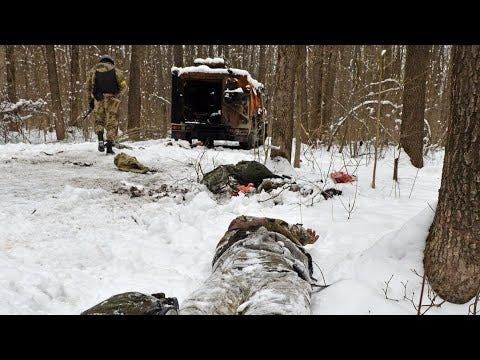













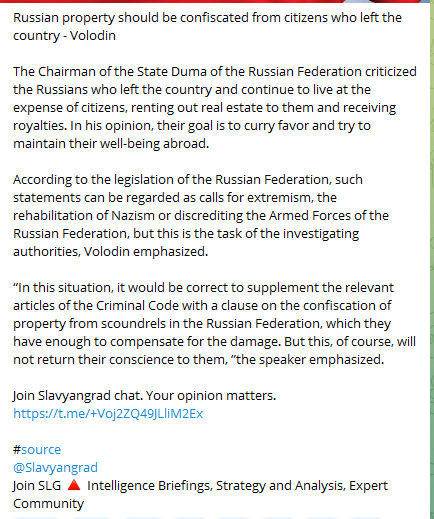




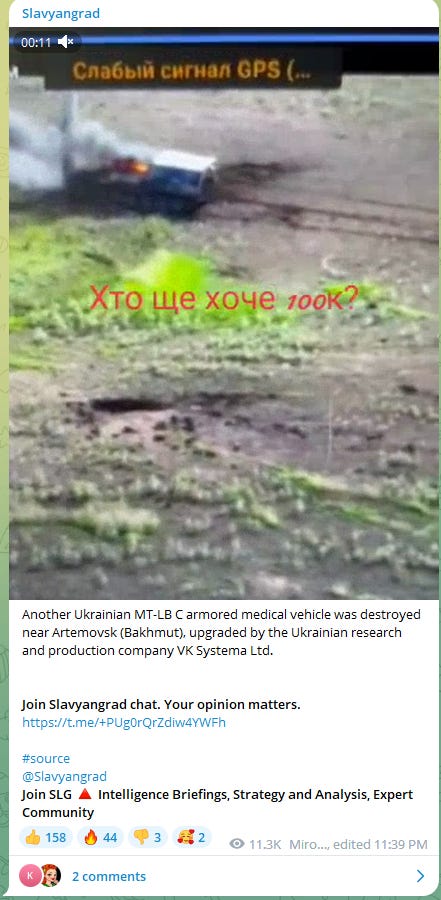

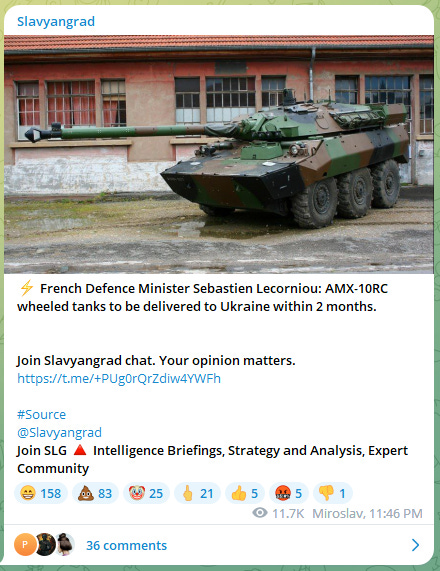



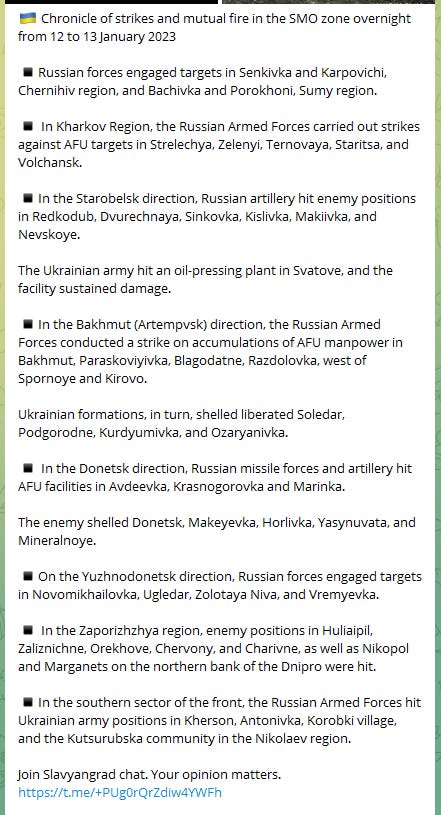




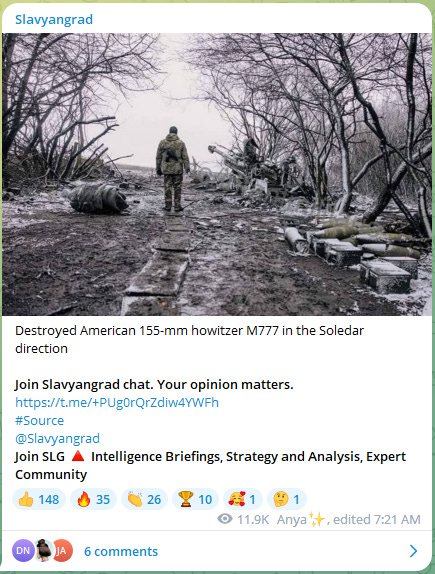




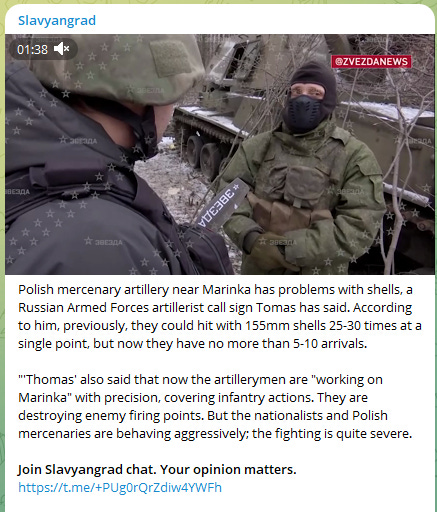
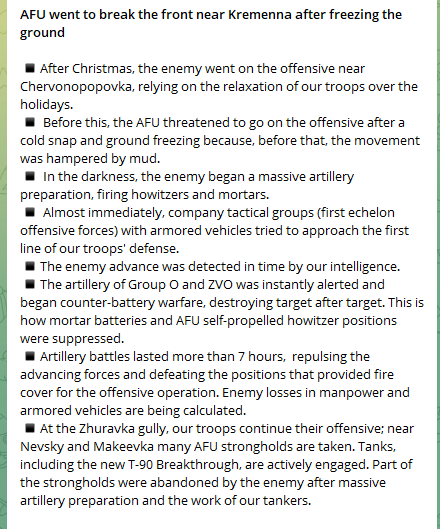






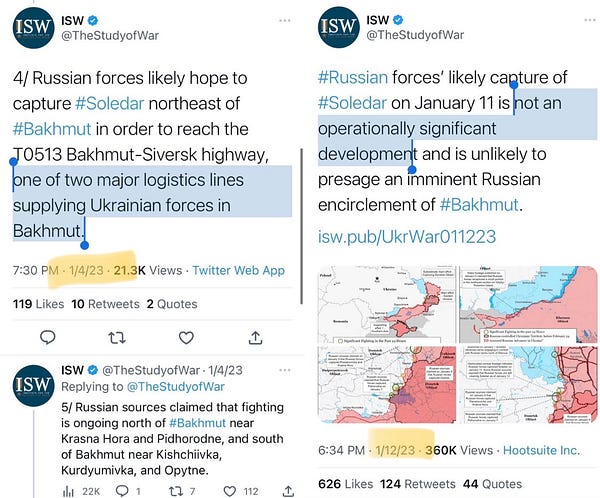

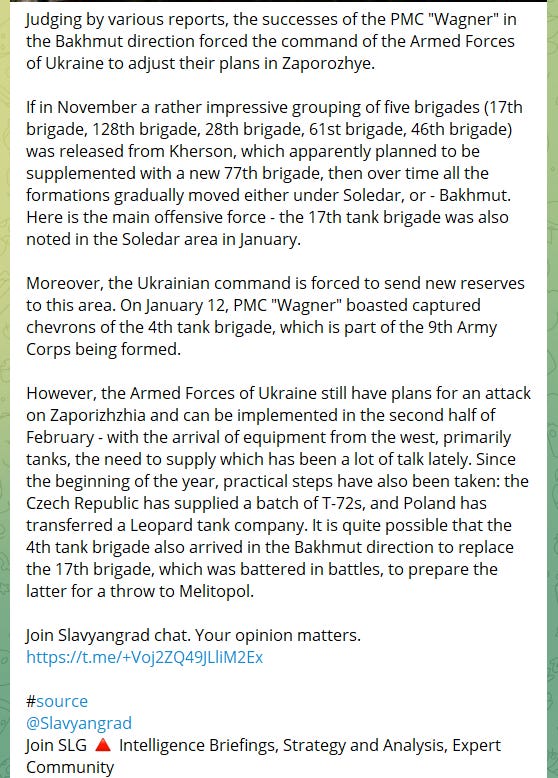
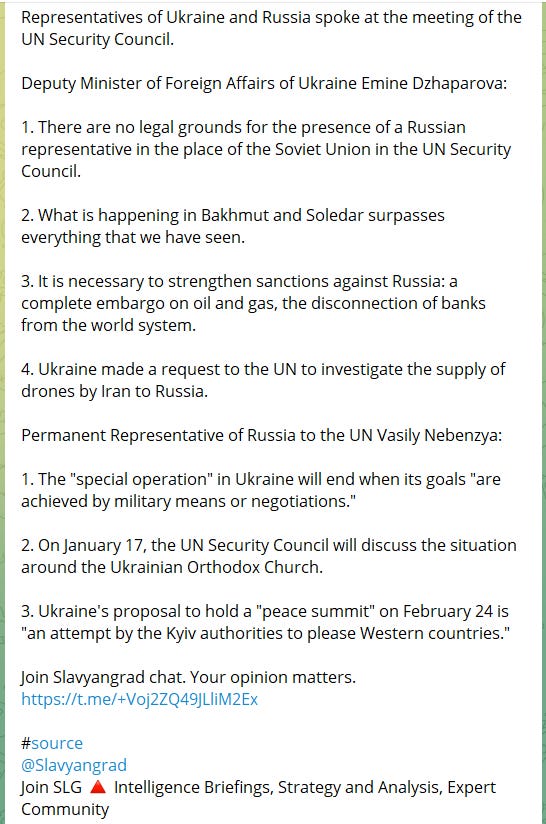

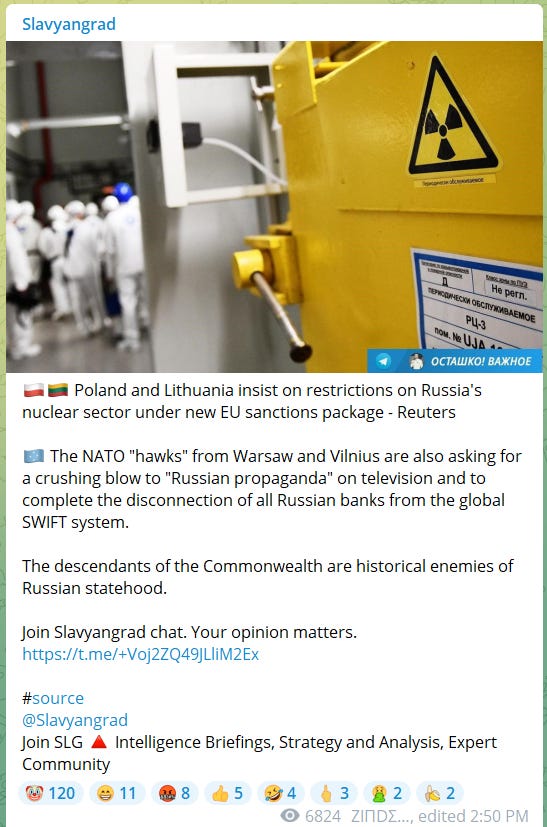
I'm glad you kept in the video of the dead AFU infantry in Soledar. Its nasty sad but its real and the leaders who send people to fight and die in senseless wars should have to watch it at least once a day as long as they have those jobs...
https://grasshoppper.substack.com/p/anticipating-the-great-narrative